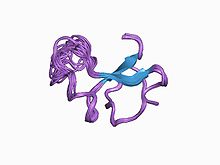The insulin-like growth factor-binding protein (IGFBP) serves as a transport protein for insulin-like growth factor 1 (IGF-1).[2]
| Insulin-like growth factor binding protein | |||||||||||
|---|---|---|---|---|---|---|---|---|---|---|---|
 Structure of the IGF-binding domain of the insulin-like growth factor-binding protein-5 (IGFBP-5)[1] | |||||||||||
| Identifiers | |||||||||||
| Symbol | IGFBP | ||||||||||
| Pfam | PF00219 | ||||||||||
| InterPro | IPR000867 | ||||||||||
| SMART | SM00121 | ||||||||||
| PROSITE | PDOC00194 | ||||||||||
| SCOP2 | 1boe / SCOPe / SUPFAM | ||||||||||
| |||||||||||
Function
Approximately 98% of IGF-1 is always bound to one of six binding proteins (IGF-BP). IGFBP-3, the most abundant protein, accounts for 80% of all IGF binding. IGF-1 binds to IGFBP-3 in a 1:1 molar ratio. IGF-BP also binds to IGF-1 inside the liver, allowing growth hormone to continuously act upon the liver to produce more IGF-1.
IGF binding proteins (IGFBPs) are proteins of 24 to 45 kDa. All six IGFBPs share 50% homology with each other and have binding affinities for IGF-I and IGF-II at the same order of magnitude as the ligands have for the IGF-IR.[3]
The IGFBPs help to lengthen the half-life of circulating IGFs in all tissues, including the prostate.[4] Individual IGFBPs may act to enhance or attenuate IGF signaling depending on their physiological context (i.e. cell type). Even with these similarities, some characteristics are different: chromosomal location, heparin binding domains, RGD recognition site, preference for binding IGF-I or IGF-II, and glycosylation and phosphorylation differences.[5] These structural differences can have a tremendous impact on how the IGFBPs interact with cellular basement membranes.
Family members
In humans, IGFBPs are transcribed from the following seven genes:
See also
References
External links
- Insulin-like+growth+factor+binding+proteins at the U.S. National Library of Medicine Medical Subject Headings (MeSH)